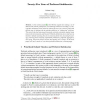Free Online Productivity Tools
i2Speak
i2Symbol
i2OCR
iTex2Img
iWeb2Print
iWeb2Shot
i2Type
iPdf2Split
iPdf2Merge
i2Bopomofo
i2Arabic
i2Style
i2Image
i2PDF
iLatex2Rtf
Sci2ools
BIRTHDAY
2015
Springer
2015
Springer
Twenty-Five Years of Preferred Subtheories
In the seminal paper [6], Gerd Brewka argued that ranking a set of default rules without prerequisites, and selecting extensions according to a lexicographic refinement of the inclusion ordering proves to be a natural, simple and efficient way of dealing with the multiple extension (or “subtheories”) problem. This natural idea has been reused, discussed, revisited, reinvented, adapted many times in the AI community and beyond. Preferred subtheories do not only have an interest in default reasoning, but also in reasoning about time, reasoning by analogy, reasoning with compactly represented preferences, judgment aggregation, and voting. They have several variants (but arguably not so many). In this short paper I will say as much as I can about preferred subtheories in sixteen pages. 1 Prioritized Default Theories and Preferred Subtheories Preferred subtheories were introduced in [6] as a way of representing and exploiting priorities between default rules. Their starting point was ...
| Added | 17 Apr 2016 |
| Updated | 17 Apr 2016 |
| Type | Journal |
| Year | 2015 |
| Where | BIRTHDAY |
| Authors | Jérôme Lang |
Comments (0)

